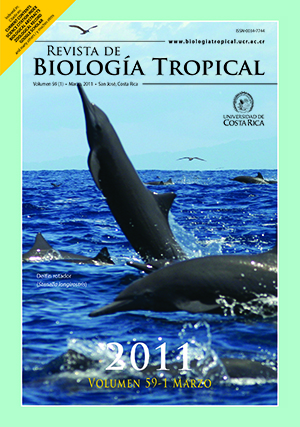Abstract
Despite their role in supporting diverse marine fish communities, tropical rocky shores and reefs have attracted less research and fewer targeted conservation efforts compared to coral reefs. We studied fish community composition in Playa Blanca Marine Reserve (9°40' N - 84°40' W), a rocky shore site on the central Pacific coast of Costa Rica. We conducted visual surveys of fishes along six strip transects soon after the area was designated a marine reserve in 1995, then again in 2006 following an eleven-year period of complete protection. We recorded a total of 31 406 sightings of 72 species from 30 families. Pomacentrids (42.5%), labrids (16.6%) and haemulids (14.8%) dominated the community, accounting for > 70% of total fish abundance. In comparison to other sites in the region, the fish community was more similar to one reported from Bahia Honda, Panama (7°50' N - 81°35 W) than from the geographically more proximate Culebra Bay, Costa Rica (10°45' N - 85°43 W). Sixty-one species from 26 families were recorded in 1995; sixty-nine species from 28 families in 2006. Our results suggest that the Playa Blanca Marine Reserve is fulfilling its conservation role. Average fish abundance, species richness and Shannon?s index of community diversity were greater in 2006 than 1995, and fish community composition varied significantly within each transect among years. Much of the change in community composition among years resulted from spatial and temporal variation in the abundance of a few dominant species, including Abudefduf troschelli, Thalassoma lucasanum, Chromis atrilobata, and Stegastes flavilatus/acapulcoensis. Of the 48 species/species groups recorded in both years, 37 (77%) were more abundant in 2006 than 1995, and several species recorded as uncommon or rare in 1995 were more frequent and abundant in 2006. Fish community composition and the abundance of some species changed in the reserve over time, but further study is needed to determine the role of small-scale marine reserves in the conservation of tropical marine biodiversity. Rev. Biol.+ Trop. 59 (1): 233-246. Epub 2011 March 01.Comments

This work is licensed under a Creative Commons Attribution 4.0 International License.
Copyright (c) 2011 Revista de Biología Tropical
Downloads
Download data is not yet available.






